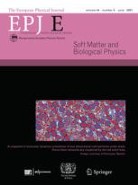Our humble contribution to the fight with COVID-19 pandemic is out in the OPEN ACCESS: EPJE 44 (11), 2021.

Phospholipids dock SARS-CoV-2 spike protein via hydrophobic interactions: a minimal in-silico study of lecithin nasal spray therapy
- @ribelousov
- in touch with @edgarroldankb’s lab, @ictpnews.
M.N. Nawaz Qaisrani, R. Belousov, J.U. Rehman, E.M. Goliaei, I. Girotto, R. Franklin-Mergarejo, O. Güell, A. Hassanali & É. Roldán.
Understanding the physical and chemical properties of viral infections at molecular scales is a major challenge for the scientific community more so with the outbreak of global pandemics. There is currently a lot of effort being placed in identifying molecules that could act as putative drugs or blockers of viral molecules. In this work, we computationally explore the importance in antiviral activity of a less studied class of molecules, namely surfactants. We employ all-atoms molecular dynamics simulations to study the interaction between the receptor-binding domain of the SARS-CoV-2 spike protein and the phospholipid lecithin (POPC), in water. Our microsecond simulations show a preferential binding of lecithin to the receptor-binding motif of SARS-CoV-2 with binding free energies significantly larger than kBT. Furthermore, hydrophobic interactions involving lecithin non-polar tails dominate these binding events, which are also accompanied by dewetting of the receptor binding motif. Through an analysis of fluctuations in the radius of gyration of the receptor-binding domain, its contact maps with lecithin molecules, and distributions of water molecules near the binding region, we elucidate molecular interactions that may play an important role in interactions involving surfactant-type molecules and viruses. We discuss our minimal computational model in the context of lecithin-based liposomal nasal sprays as putative mitigating therapies for COVID-19.